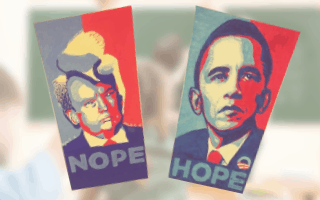


From time to time, accusations of indoctrination are leveled at the government-run education system, and we’re reminded to review the textbooks, lesson plans, student essays, or artwork to get a clearer picture of what kids are learning. Last month, anti-Trump ceiling tiles painted by students at Wood River High School fired up debate on social media about whether schools are indoctrinating kids.
The tile paintings include a replication of Barack Obama’s red, white, and blue “Hope” campaign poster along with a similarly-styled representation of President Donald Trump with the word “nope” underneath. Another painting depicts doctorate degree-earning “dreamers” leaving the United States juxtaposed with Trump supporters as uneducated hillbilly buffoons in their red MAGA hats who are staying.
Blaine County School District officials told reporters last week that kids have been painting ceiling tiles at Wood River High School for years, as part of an advanced placement extra credit program. And, district officials say, the paintings are bipartisan because there’s one of Abraham Lincoln, the first Republican president, and another that is pro-Trump, depicting the president’s efforts to free businesses from government regulation.
Glenneda Zuiderveld of Jerome posted pictures of the Wood River High School artwork on Facebook. There, she questioned the propriety of the tile-painting tradition. Zuiderveld, who ran for the state Legislature a couple of years ago, has since been inundated with hateful messages for merely questioning the tradition.
But kudos to her for bringing attention to the issue. There’s a huge need for more of that. Over the years, there have been few attempts to really scrutinize what schoolchildren are learning and whether they’re getting a slanted portrayal of government and American civics. I pointed this out almost nine years ago when I wrote in my weekly column that Idaho student textbooks offer a warped view of American government. Kids are taught America’s governing document is a “living constitution” malleable by the moment in a “democracy” where government possesses unending powers to care for its citizens.
Things seem to have only gotten worse. At the Idaho Freedom Foundation, we’ve been poring over books approved for use in Idaho’s public schools. Many of the textbooks hail the advent of government programs and couch capitalism as an impediment to the wellbeing of Americans. Government is depicted as a problem-solver. Capitalism, free markets, or limited government are rarely, if ever, similarly handled. Socialism quite often is given special deference, described in one textbook as a mechanism to “ease any economic injustices caused by capitalism.”
Today’s textbooks extol the virtues of Franklin Roosevelt, touting “the positive effects of the New Deal,” which “saved the lives of millions of Americans who were penniless, starving, and homeless.” Social Security, unemployment insurance, and other federal government programs have given “Americans a sense of security and a quality of life that is constantly improving.” Who would oppose such a thing? “Not surprisingly,” says the same book, “wealthy businessmen [who] resented the fact that President Roosevelt’s tight regulations on their businesses were costing them money.”
Another textbook describes Planned Parenthood as “a pro-choice nonprofit group that provides information on family planning and funds research on women’s health issues.” That’s a depiction of a group with a mission so vanilla the organization couldn’t possibly merit real objection.
It’s no wonder that kids view capitalism and free enterprise with skepticism. It’s no wonder they’re excited by people like Bernie Sanders and Alexandria Ocasio-Cortez and other socialists who have captured the American political spotlight of late.
Cartoon depictions on the ceiling at Wood River High School are but a symptom of a greater problem, that of kids being presented with a biased view of what American government is all about. Parents and taxpayers need to ask more questions as to what kids learn in public schools.

